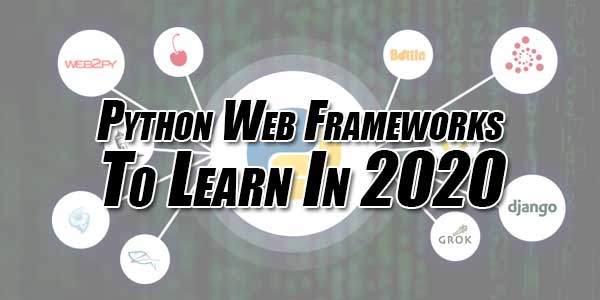
Python is a multi-purpose and powerful programming language made by Guido van Rossum. It consists of simple to use syntax that is it is an ideal language in order to learn computer programming. It’s exciting to work in Python since it enables you to consider the issue as opposed to concentrating on the syntax. This is all since it has a remarkable syntax which makes it a unique programming language that is accessible in the IT business so it is a user-friendly language and can be used by both the developers and beginners.
Table of Contents
What Are Web Frameworks?
Frameworks provide design in application development for the developers. Thy work to implement the critical solutions resulting in less development time and make the developers concentrate on application logic regardless of regular components. Frameworks act just as a present for the developers since it makes the life of developers much easier and happy. Since python is likewise utilized by the developers a considerable amount in the web development industry. on account of its readability, practicality in a helpful way. When it comes to python web development then there are two parts on which we need to focus on the front-end and back-end of an application. The backend framework carries the languages and tools that are used on the server-side. python is utilizing more while building up the backend part of an application.
Python Frameworks To Learn:
1.) Web2py:
Web2py is a versatile open-source full-stack Python system. It’s exceptionally incredible with regard to handling data. In the beginning, it is preferred as a teaching tool to concentrate on its user-friendliness, it clears the reason for which there are files documents for project-level designs. The web-based IDE in Web2py makes it incredible as it includes the debugger, one-click deployment, and code manager. There are some important features which include:
Features:
- No requirement of installation and configuration
- Ability to run on Mac, Google App Engine, Windows, Linux/Unix, Amazon EC2, and other web hosting that supports for one of both Python 2.5–2.7 or Java+Python
- Several protocols’ Readability
- Data security which incorporates the vulnerabilities like malicious file execution, cross-site scripting, and injection flaws.
- Effective work of software engineering works on, making code simple to read and keep up
- Error tracking, careful error logging, and ticketing
2.) Django:
Django is a significant level Python Web application development framework that urges us to create things quickly, It utilizes pragmatic design. It is mainly used by experienced web developers and basically it deals with the problem of Python Web development, so it saves your time when writing your application. It’s free and open source.
Features:
- Supports content administration, user authentication, site maps, and many more tasks
- Helps the developers to avoid common errors
- Provide flexible scale for heavy traffic demands
- Used to build all sorts of things like content management systems, social networks
3.) Turbo Gears:
TurboGears is a data-driven, and open-source, full-stack web application framework. It is dependent upon several libraries and was initially created for the best parts of other Python frameworks. TurboGears helps you to quickly create effective data-driven web applications. It accompanies an easy to use the templating engine and an incredible and adaptable ORM. for building the web application it needs very less set-up. With the assistance of Javascript developer tools, developers can essentially the web application.
Features:
- To combine with MochiKit Javascript library.
- It underpins SQLObject and SQLAlchemy.
- Command-line tools
- It underpins various databases.
4.) Flask:
It is the microframework for Python based on Jinja 2, and Werkzeug. The main thing is to develop a strong base for you web application. When contrasted with Django, Flask is most appropriate for easy and small projects.
Features:
- Lightweight framework.
- Efficient with Google App Engine.
- Have Built in development debugger and server.
5.) Bottle:
It is a fast, simple and also lightweight WSGI smaller scale web-framework for Python. It is dispersed as a singular file module and also has no conditions other than the Python Standard Collection. It is a light-weight system for the most part utilized to construct small internet applications. It is generally utilized to produce API’s.
Features:
- It enables clients to get to shape data, cookies, file uploads, and other HTTP-related metadata in an a lot easier way.
- HTTP server is in-built.

6.) CherryPy:
It utilizes the Object-Oriented paradigm to create web applications. This methodology encourages engineers to create web applications in a short timeframe.
Features:
- It has a flexible plugin and a powerful configuration framework.
- It can easily run on numerous HTTP servers on the double.
- It has Built-in tools for encoding, sessions, caching, authentication, static content, and some more.
7.) Tornado:
Tornado can scale to numerous open links by using non-blocking network I/O, making it excellent for the long ballots, WebSockets, as well as various applications that call for a seemingly continuous link with every client.
Features:
- Non-blocking HTTP customer.
- It has a high-quality execution.
- It enables us to actualize third-party verification and approval plans i.e (Google, Facebook, Twitter)
8.) CubicWeb:
CubicWeb is a semantic, free and open-source Python web framework, that engages developers to effectively create web applications by reusing segments (called cubes) and following the outstanding object-oriented design standards. It is a good solution for semantic web application development which develops quality, reusability, and productivity.
Features:
- It has a great work process with security.
- It likewise underpins for Resource Description Framework (RDF) and Web Ontology Language (OWL).
- It has Relational Query Language (RQL) to rearrange the questions identified with data.
9.) Pyramid:
It is an open-source Python-based web application framework and it can possible with less complexity. Running on Python 3, Pyramid stays aware of technological upgrades. Pyramid 1.10 is the present version of the system and is the tenth update since 2010. The most important element of the Pyramid is the ability to work admirably with both types of applications whether small or big. A portion of the Pyramid’s incredible features include:
- Single-record applications
- URL generation
- Extensible configuration
- Widely inclusive templating and resource details
- Adaptable authentication and approval
- Testing, backing, and comprehensive data documentation
10.) Falcon:
Falcon is a bare-metal Python web API system for building extremely quick application backends. Falcon is designed as The logo of the framework, which shows how quickly it works. The developers can make their designs cleaner and handle most of the demands with this framework. Falcon never limits developers in picking libraries for databases and approval. Other significant Falcon features:
Features:
- 100% code inclusion with a thorough test suite
- A profoundly streamlined codebase
- Upfront exception handling
- REST-roused resource classes
- URI templates for regular routines
- Simple access by means of request and response classes
- DRY request processing by means of middleware parts
11.) Hug:
Hug is a Python 3 API development framework. For creating an API, it is designed to give permission to the software developers so you can reuse it whenever required. This framework offers several interfaces to disentangle API development. The structure is known as the faster one in Python 3 which is the main reason for this.
Features:
- Supporting automatic documentation
- Built-in version management is in-built
- Powered with Annotation validation
- Consistency with Cython
- Can be utilized as a Python library

 About the Author:
About the Author:
















Be the first to write a comment.